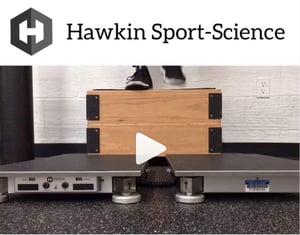Muscle Actions & Reactive Ability
Reactive strength is an indirect measure of the neuromusculoskeletal system and the athlete’s ability to efficiently accept and reverse energy into dynamic movement. It is highly dependent on the neural capacity of the athlete, and also their mechanical capacity.
The mechanical capacity of the athlete is the efficiency in which the athlete can transmit energy through their muscles, tendons, ligaments, bones, and fascia to produce dynamic movement. Mechanical capacity can further be broken down into three muscle actions which include eccentric, isometric, and concentric muscle actions.
When looking at a countermovement jump (CMJ) and specifically the leg extensor muscles, eccentric muscle action occurs when the athlete is transmitting force down into the force plate (i.e. braking force). This is represented visually as the athlete dips down pre-jump, also known as the “countermovement”. This countermovement and eccentric muscle action allows the athlete to harness the capabilities of the powerful neuromuscular stretch-reflex, and also the stored elastic energy housed in the tendons.
Isometric muscle action occurs only for a brief period of time and is often difficult to see in real time. This is also called the amortization phase and is represented visually as the period of time when the athlete reverses direction and begins to jump vertically (i.e. propulsive force). This concentric muscle action of the leg extensors is the main driving force behind the propulsive phase.
Tests of Reactive Strength
The Hawkin Dynamics software has three built-in assessments of reactive strength. These assessments include the drop jump, the countermovement rebound, and the multi rebound. Each assessment will tell you the reactivity of your athlete, but will also tell you something slightly different.
1. Drop Jump (fast)
2. Countermovement Rebound (lower barrier to entry than drop jump)
3. Multi Rebound (faster, more ankle dominant)
When considering the nature of all three assessments and the time constraints involved, they can generally be broken down into two categories. These two categories are based on the constraints of the SSC demand and also time spent on the ground (i.e. GCT).
The two reactive strength categories can be classified as either fast SSC (i.e. anything under 250 ms, typically small angular displacement), or slow SSC (i.e. anything over 250 ms, greater angular displacement) (1). Examples are provided below for each classification.
Fast SSC test examples:
-
Drop jump from a low box
-
CMJ rebound when the first CMJ is submaximal
-
Multi rebound using submaximal jumps
Fast SSC sport examples:
-
One-foot jumper in basketball
-
Middle hitter in volleyball going up for a block
Slow SSC test examples:
-
CMJ
-
Drop jump from a higher box (also sometimes called a depth jump)
-
CMJ rebound when the first CMJ is maximal
-
Multi rebound using all maximal jumps
Slow SSC sport examples:
-
Two-foot jumper in basketball
-
Outside hitter in volleyball approaching the net for a spike
Countermovement Rebound Test
Drop Jump from 30cm Box
The reason why the same assessments can fall into both classifications is because as the athlete spends a longer time on the ground between jumps, the nature of the SSC changes and ground contact time (GCT) increases. Therefore, making the assessment more of a measure of slow SSC, as opposed to fast SSC. It has also been suggested in previous research that any GCT over 1.0 second significantly diminishes the ability of the SSC to return energy (2). This should be taken into consideration when programming exercises that are intended to be reactive.
Metrics of Reactive Strength
All three of these assessments will give you an array of metrics. It is ultimately up to the practitioner to decide how they will use each metric for programming and assessment purposes.
With that being said, a few metrics stand out when considering reactive strength. These metrics include reactive strength index (RSI), reactive strength index modified (mRSI), jump height (JH), and also the time segments of each phase (i.e. braking phase and propulsive phase duration). The sum of braking phase, amortization phase, and propulsive phase time can be used to determine the GCT of the test.
Research often used RSI, or mRSI as assessments of reactive strength. The following equations are how each metric is derived:
RSI = Flight Time / GCT
mRSI = Jump Height / GCT
When comparing these metrics against research derived norms, it is important to understand if the research is using RSI or mRSI. A lot of times the distinction is not made clear whether the RSI calculation is using jump height or flight time. Both of which could give you different RSI values.
Sources:
- Schmidtbleicher D. Training for power events. In P.V Komi (Ed.),The Encyclopeadia of Sports Medicine. Vol 3: Strength and Power in sport (pp. 169-179), 1992. Oxford, UK: Blackwell.
- Turner, A.N., & Jeffreys, I. (2010). The Stretch-shortening Cycle: Proposed Mechanisms and Methods for Enhancement.
-2.png?width=156&height=60&name=Hawkin%20Logo%20(2)-2.png)
-1.png?width=155&height=60&name=WHITE.Horizontal_Logo.Transparent%20(3)-1.png)

